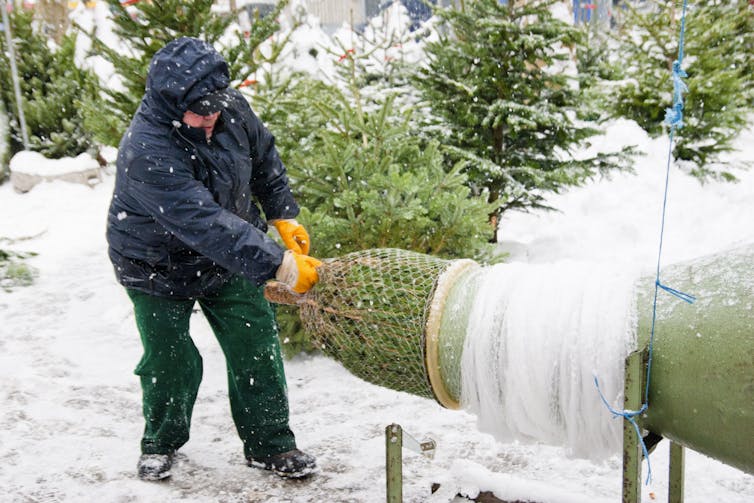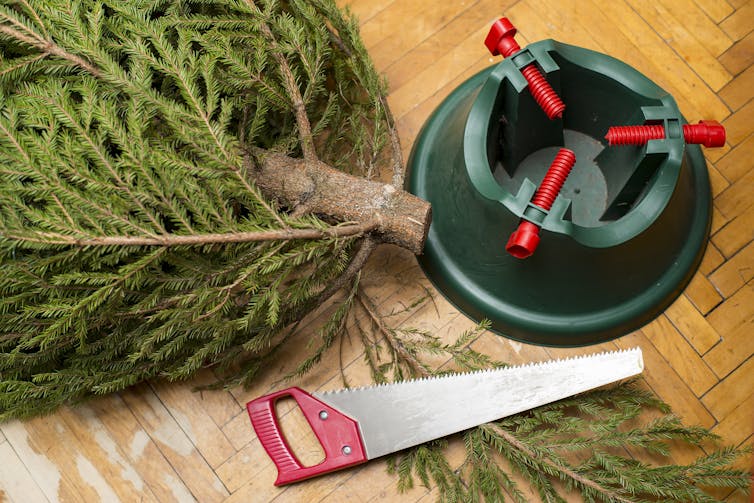Christmas trees can stay fresh for weeks – a well-timed cut and consistent watering are key
From picking the tree to getting it home to setting it up, the choices you make can help it stay fresher – and safer – longer.

Every year somewhere between 25 million and 30 million Christmas trees are sold in the United States. If you’re one of the people who decorate for the holiday with a freshly cut Christmas tree, you might be wondering how to keep it looking good all the way through Santa’s visit – and maybe even a little beyond.
Curtis VanderSchaaf is a forestry specialist at the Mississippi State University Extension Service who knows a thing or two about conifers. The Conversation U.S. asked him for guidance on how to keep a fresh green Christmas tree from becoming a giant pile of brown needles, for as long as possible. Whether you end up with a Douglas fir, a Scotch pine, a Leyland cypress, a piñon or any other evergreen, he says the quality of care you provide is a major factor in the prolonged freshness of your tree.
What to consider when choosing a tree
Select a tree that looks fresh and whose needles are not brittle. You want one that has a strong fragrance and a dark natural green color. Avoid bored holes in the wood, signs of bugs – like spider egg sacs – and other marks of pest damage. This advice holds whether you’re chopping down your own tree or buying it from a retailer.
Different species of trees have various colors, shapes, branching habits, needle types, scent and even bark type. Depending on what’s available to you, this comes down to personal preference.
If you can, pick a tree that’s been harvested as recently as possible and been watered and kept cool. Often a tree’s freshness is directly related to the moisture content of its needles. If the stump – where the tree’s trunk was cut – is sticky with sap, that’s a good sign.
Give the tree a good shake, even a hard pound on the ground. That will dislodge any animal stowaways. If a ton of dead needles or dry limbs fall out, keep looking.

Getting your tree home
Tree farms and retail lots will net your tree. It’s a lot easier to transport with the branches tucked in. If you’re going to bring it home on top of your car, consider using a tarp to keep scratches and sap off your vehicle. Make sure the tree is securely tied down, with the trunk facing forward to reduce wind damage to the branches. Take it easy on the road.
If you’re not bringing your tree indoors right away, store it in a cool, damp area that is blocked from wind and out of the sun.
Make a fresh, straight-across cut on the butt of the tree about a half-inch to 1 inch (1 to 3 centimeters) above the original cut. After any cut, a tree tries immediately to seal off, or compartmentalize, the injury, which makes it hard for the tree to take up water. So as soon as you make the new cut, place the tree in a bucket of warm water. Make sure it stays full as the tree drinks.
If you have allergies, you may want to spray the tree with a garden hose to remove residual pollen or dust – as long as the weather’s not freezing.

Setting up your tree inside
To keep a cut tree fresh you need to provide adequate water. Use a tree stand with a built-in reservoir, and make sure it’s always filled. A rule of thumb is 1 quart of water per inch of stem diameter. A freshly cut tree may use one-half to 2 gallons of water the first day, but this amount will taper as the tree acclimates to its indoor environment.
You don’t need to worry about adding anything to the water. It seems to just be an old wives’ tale that anything – including corn syrup, aspirin, vodka, soda pop, sugar or any specialized preservatives or gels – beyond H₂0 helps prolong the freshness of the tree. No special temperature is necessary either, just not freezing cold or boiling hot.
Do not drill a hole in the bottom of the tree trunk thinking it will improve water uptake – it doesn’t.
If you have to whittle down the sides of the trunk to fit, the tree is too large for your stand. It’s the outer layers of wood that take up most of the water, so if you shave them off your tree will be in trouble.
Secure the tree in its stand, ensuring the freshly cut stump is submerged. If it’s ever out of the water for more than about a quarter-hour or so, the cut starts the healing and sealing process and you should think about making a new cut.

Keeping the tree fresh into the New Year
Once your tree is all set up, your goal is to keep it from drying out. Remember, you want your tree to be fresh, but more importantly you don’t want to create a fire hazard.
Keep the tree at least 3 feet (1 meter) from any heat source and minimize direct sun exposure. Lowering the temperature in the room may also help to maintain freshness.
Make sure any lights and their cords are in good condition and turn them off when you aren’t present. Unplug completely if you are leaving the house or going to bed. Occasional breaks from using the lights may help slow the tree’s drying-out process. And make sure your smoke detectors work and you have a fire extinguisher on hand just in case.
If properly cared for, a fresh tree will last for three to four weeks, often even five. If it starts to get dry at any point, the safest move is to get rid of it. Chipping it for compost is the most environmentally sustainable option when it’s time for the tree to go.
Then you can start enjoying the lengthening days and look forward to the next holiday on your calendar.
As an Extension Forester, Curtis VanderSchaaf has worked with Christmas tree growers in his region.
Read These Next
From truce in the trenches to cocktails at the consulate: How Christmas diplomacy seeks to exploit s
World leaders like to talk up peace at Christmastime. But alongside the tales of seasonal breaks in…
As DOJ begins to release Epstein files, his many victims deserve more attention than the powerful me
Powerful men connected to Jeffrey Epstein are named, dissected and speculated about. The survivors,…
Medieval peasants probably enjoyed their holiday festivities more than you do
The Middle Ages weren’t as dreary and desperate as you’d think, and peasants often had weeks of…





